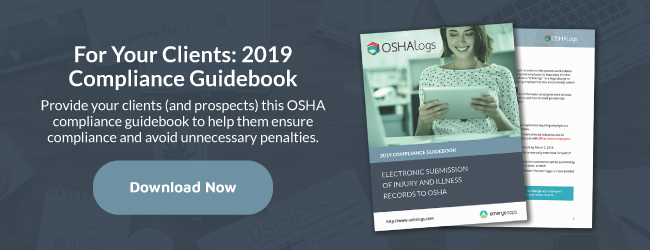
OSHA has announced that they will be using the illness and injury records submitted electronically by employers for calendar year 2016 to create the Site-Specific Targeting 2016 (SST-16) inspection plan. This plan changes the way OSHA targets employers for inspection, and it is vital that agents prepare their clients for a possible OSHA visit. Comprehensive OSHA inspections occur without notice and can lead to sizable fines for any violations.
Don’t leave the door open for other agents by failing to speak to your clients about what to expect and how to handle OSHA visits, should they occur. Educate clients (and prospects) now.
Who is targeted by SST-16?
OSHA will use SST-16 to target three classes of general industry for comprehensive inspection. The plan does not target construction worksites and will be used in addition to OSHA’s previous method of targeting specific hazards for inspection. The new categories being targeted are:
-
High Rate Establishments – These are establishments with elevated days away, restricted or transferred rates (DART) based on the data submitted on form 300A. Different DART rates will be used for manufacturing and non-manufacturing establishments, with the goal of achieving a 50/50 balance for inspections.
-
Low Rate Establishments. Representative establishments with low DART rates will be identified for inspection to address concerns of under-reporting of injury and illness and help verify data accuracy.
-
Establishments that failed to provide 300A data to OSHA – By targeting a random sampling of establishments that did not submit data to OSHA, they hope to boost compliance with the electronic recordkeeping requirement. Some estimates show that barely half of establishments required to submit data electronically have done so.
-
Agents, this is another opportunity to provide value to your clients. Make sure they have submitted prior year data and that they comply with the upcoming March 2 deadline for submitting 2018 300A data.
OSHA appears not to be targeting establishments that they have deemed to be operating with average DART rates for their industry.
State-run programs have until April 16, 2019, to decide whether to adopt the same federal OSHA inspection plan or to develop their own targeting guidelines. For now, employers in all states would be well-served to prepare for inspection based on the new federal targeting.
How should you prepare clients for an OSHA visit?
The best way to prepare for a comprehensive OSHA inspection is to be proactive. Employers should review the OSHA guidelines for their industry and be prepared for an inspection that will not be limited to recordkeeping or specific hazards. Rather, employers should prepare for a possible inspection of the entire facility and limit exposure by taking the following steps:
-
Establish whether they are subject to the OSHA electronic recordkeeping requirement and, if so, confirm that they did, in fact, submit the required data. Employers should make sure to submit all data by the deadline in the future (March 2, 2019, and annually that same date going forward).
-
Check the DART rate for their establishment against the comparable industry rate. If the rate is significantly below average, it is worth auditing the data for accuracy.
-
Establish if any specific hazards have led to an increase in workplace illness and injury by auditing the logs. Check to make sure these hazards have been appropriately addressed to avoid future injury.
-
Review workplace safety programs. Make sure all known hazards are properly addressed and confirm the official safety programs meets OSHA standards.
For smaller businesses, OSHA offers a free On-Site Consultation Program to help employers comply with regulations. This program is separate from OSHA enforcement and does not result in penalties or citations. In some cases, employers may qualify for a one-year exemption from routine OSHA inspections by participating in the consultation program. This is an excellent program to recommend to any smaller clients who need help meeting current OSHA regulations.
Ensure that clients and prospects are prepared for OSHA inspections and are aware of their reporting and documentation requirements! Provide this 2019 OSHA Compliance Guidebook to help them comply with this year’s recordkeeping requirements.

